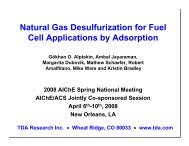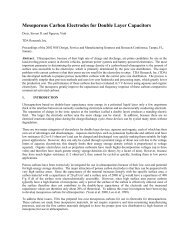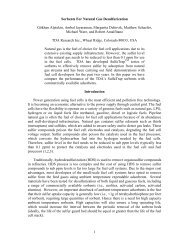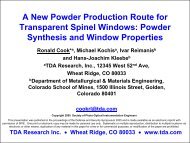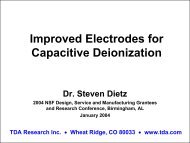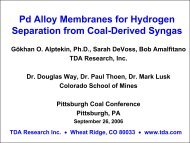Transparent Spinel Fabricated from Novel Powders: Synthesis ...
Transparent Spinel Fabricated from Novel Powders: Synthesis ...
Transparent Spinel Fabricated from Novel Powders: Synthesis ...
You also want an ePaper? Increase the reach of your titles
YUMPU automatically turns print PDFs into web optimized ePapers that Google loves.
protection in the form of face shields and visors, windows for ground vehicles such asHUMVEES and armored cars, and windshields and lookdown windows for aircraft.<strong>Spinel</strong> (MgAl 2 O 4 ), AlON, and sapphire are the leading candidates for these applications[2,3], and developmental efforts are underway in all three materials to meet the demandfor increasingly larger components (4-7).Magnesium aluminate spinel (MgAl 2 O 4 ) is a ceramic with a cubic crystal structurecharacterized by magnesium ions tetrahedrally coordinated with oxygen and aluminumoctahedrally coordinated with oxygen. A unit cell contains 32 oxygen ions, 16 octahedralcations, and 8 tetrahedral cations. The generic form of spinel is AB 2 O 4 where A aredivalent ions such as Zn, Cd, Mg, Fe, Mn, Ni, or Co and the B are trivalent ions like Al orFe. Most varieties of spinel are not transparent and are known more for their magneticproperties. MgAl 2 O 4 however, in its pure polycrystalline form, can be processed intotransparent optically isotropic components. <strong>Spinel</strong> is transparent to electromagneticradiation <strong>from</strong> the ultraviolet through the mid-infrared (0.2 to 5.5 microns). As depictedin Figure 1, spinel has a distinct transmission advantage over sapphire and AlON <strong>from</strong>4.5 to 5.5 µm, a region of particular importance for seeker and electro-optic imagingsystems. Optical scatter is generally very low due to spinel’s cubic crystal structure;however, porosity and impurities at grain boundaries can increase both scatter andabsorption.Figure 1. Transmission spectra for infrared materials. Reproduced <strong>from</strong> [8].In processing of polycrystalline, transparent spinel, the volume fraction of second phasesand porosity must be minimized. Though high-quality transparent spinel has beenproduced successfully [2-4], the densification mechanisms, and in particular the role ofLiF as a sintering aid is still not well understood. During the last several years, muchhigher purity starting powders of spinel have become available so that better control overimpurity levels is possible. The present study describes experiments that are designed tounderstand how LiF contributes to late stage sintering of spinel.
EXPERIMENTAL TECHNIQUESPowder PreparationThe MgAl 2 O 4 powders used to prepare transparent spinel parts were produced in a threestep, single pot process [9,10]. The first step was the hydrolysis of aluminum secbutoxide(Al(CH 3 CH(O)CH 2 CH 3 ) 3 (ASB, Chattem Chemicals) to produce a boehmite sol.ASB <strong>from</strong> Chattem Chemicals is a liquid at room temperature and has less than 5ppmimpurities. Hydrolysis of the ASB was carried out in 80 °C distilled water. At 80 °C, thekinetically stable hydrolysis product is boehmite (i.e., Al(O)OH)) instead of gibbsite,Al(OH) 3 , that forms by hydrolysis of ASB at lower temperatures. After hydrolysis wasstarted the mixture was peptized using a carboxylic acid. Additional acid was then added toconvert the nanosized boehmite particles to carboxylate-surface-modified boehmitenanoparticles. The mixture was heated overnight and then Mg(acac) 2 was added to thereaction mixture along with additional water. One set of spinel powders was synthesized<strong>from</strong> ultra-high purity Mg(acac) 2 which did not contain parts per million impurities thatthe less pure Mg(acac) 2 contained. As shown below, this had a dramatic result on thetransparency. The reaction mixture was then stirred for an additional two hours at 80 °Cwherein the magnesium <strong>from</strong> the Mg(acac) 2 exchanges with aluminum at the boehmitesurface. The exchanged Al 3+ forms aluminum acetylacetonate. The resulting mixture wasthen cooled to room temperature and spray-dried. This process produces a fine whitepowder with a high surface area of ~250 m 2 /g and is indistinguishable <strong>from</strong> boehmite byXRD analysis.The spray-dried Mg-doped boehmite powders were then heated to produce the MgAl 2 O 4powders for use in hot-press experiments. Heating the carboxylate-surface-modifiedboehmite powders to temperatures exceeding 500 °C causes the loss of the carboxylicacid at ~300 °C and transformation of the Mg-doped boehmite into Mg-doped γ-aluminaby loss of water (e.g., 2Al(O)OH → Al 2 O 3 + H 2 O) at temperatures above 500 °C. Nosignificant additional transformation of the Mg-doped Al 2 O 3 after 900 °C is observed byXRD analysis. Further heating of the powders to above 900 °C in air results in thecomplete transformation of the Mg-doped alumina powders to MgAl 2 O 4 . At 1000 °C, thepowders have a relatively high surface area of ~77 m 2 /g, while additional heating to1200 °C reduces the surface area to 24 m 2 /g.Hot Pressing<strong>Spinel</strong> powders were mixed with LiF (ranging <strong>from</strong> 0.0 to 1.0 wt%), by dry-tumbling thepowders in a polyethyelene bottle containing high purity alumina mixing balls. Thepowders were densified in a Thermal Technology Inc. (model number 610G-25T) hotpress. A graphite die (diameter 25.4 mm) fixture was used with graphite foil as a liner.A pre-load of 3.5 MPa was applied prior to heating. The specimens were heated at about2 ºC/min to 1550 ºC and held for 2 hrs. A uniaxial die pressure of 35 MPa was applied atabout 1550 ºC. During the entire run a vacuum better than 10 -5 Torr, was maintained.Subsequent to hot pressing, some specimens were exposed to heat treatments at 1550 ºCin air for 10 and 50 hrs. The objective of the heat treatments was to examinemicrostructural evolution.
CharacterizationSpecimens were cut to a uniform thickness of 1.25 mm, except for one highly transparentspecimen that was cut to a thickness 2.2 mm. Specimens were polished to 1 µm or belowwith diamond polishing media. Transmissivity measurements were made with a Varian5G Spectrophometer at wavelengths 300–1400 nm. Reflectivity measurements weremade on the best specimen with the same equipment. Microstructure characterization ofthe hot-pressed spinel samples was performed by fracturing specimens in a vice andobserving by scanning electron microscopy (SEM), using a FEI Quanta600 instrumentoperating at 30 kV. In order to minimize electrostatic charging under the electron beam,samples were gold-coated (SEM).RESULTSTransmissivityTransmissivity results for dense, polished spinel specimens with varying LiF content areshown in Figure 2. The lowest transmissivity was observed for undoped spinel.(0.0 wt. % LiF), and the transmissivity generally increased with an increase in LiF,except that specimens doped with 0.50 wt. % LiF were less transparent than those dopedwith 0.25 wt. % LiF. Most remarkable however is the specimen fabricated with ultrahigh purity powder and doped with 1.00 wt. % LiF. The average transmissivity of thisspecimen is above 85 %; reflectivity was measured to be between 13 and 15 % dependingon wavelength, and thus the absorption of the specimen is nearly zero. It is also notedthat the specimen thickness (2.2 mm) is nearly twice that of the other specimens. Thespecimen is shown in the inset.1001.00 % LiF80Transmission (%)604020Ultra-high puritystarting powder1.00 % LiF0.25 % LiF0.50 % LiF0.00 % LiF0400 600 800 1000 1200 1400Wavelength (nm)Figure 2. Transmissivity data for spinel specimens containing varying amounts of LiFsintering aid. The highest transmissivity was achieved using the ultra-high purity
microscopy studies [13], the quantities may be below detection limits. It may also be thatits presence during sintering alters the grain boundary structure or chemistry in such away that the grain boundary energy is lowered. It is unlikely that the presence of LiFalters the effect of grain boundary drag by pores, as has been noted when MgO is addedas a sintering aid to make translucent Al 2 O 3 [14]. If this were the case, then undopeda)0.0% LiF 1.0% LiFa) b)5 µm 5 µmFigure 5. Fracture surface of spinel specimens annealed at 1550ºC for 10 hrs. When LiFis not added as a sintering aid, Fig. 5a, then pore coalescence is much more extensivethan when LiF is added, Fig. 5b. Pore faceting is also observed, and is more abundant inthe spinel without LiF. The grain size did not change as a result of heat treatment.spinel specimens would contain pores within the grains. The present observations of thelack of porosity on transgranular fracture surfaces of undoped spinel indicates that all thepores are located on grain boundaries. Therefore, the effect of LiF must be to alter thegrain boundary energy directly. The relative surface to grain boundary energies may alsobe important in the microstructural evolution, and these may change when LiF is present.It is further likely that the effect of LiF is modified in the presence of other impurities.This latter statement is supported by the observation that using ultra-high purity startingpowders resulted in a very different microstructure (compare Figures 3b and 3c). Therelative values of surface and grain boundary energies, and how those are influenced bythe presence of LiF must be extremely sensitive to the starting powder purity.It is noteworthy that pore coalescence into roughly cylindrical shapes (e.g., Figure 5)occurred during the heat treatment in both the doped and un-doped spinel. It is readilyshown that if the total pore volume is constant, the total surface area of a group ofspherical pores is lower than the total surface area of cylindrical pores. Thus, the porecoalescence observed here seems to be going against the driving force to minimize thesurface energy of the system. This apparent contradiction is likely due to the fact that thepores are located at grain boundaries, and the increase in surface area during coalescence
is accompanied by a decrease in grain boundary area. If LiF leaves the system duringheat treatment, this may further increase the grain boundary energy. It is likely that theonly reason pores coalesce during the heat treatment and not during hot pressing is thatthe applied stress in hot pressing provides a strong driving force to remove porosity. Thisindicates that unless the thermodynamics are altered by changing the relative grainboundary and surface energies, pressure during densification is necessary to obtaintransparent spinel. Furthermore, extended exposure to high temperature would beexpected to degrade the microstructure.CONCLUSIONSIt has been demonstrated that the microstructure and transparency are extremely sensitiveto the purity level of starting powder. In the present case, exceptional transparency wasachieved only when the solution used to incorporate Mg into the boehmite structurecontained a very high level of purity. The role of these impurities, which are presumedbe in the parts per million range, is to alter the relative grain boundary to surface energiessuch that the driving force for pore evolution and/or removal is altered. Optimization oftransparent spinel for optical, mechanical and corrosive properties will only be achievedby purposeful addition of impurities to alter the microstructural evolution. The latter willonly be possible by fully understanding the role of impurities on the correspondingboundary and surface energies.ACKNOWLEDGEMENTSOne of the authors, IER, acknowledges the U.S. Army Research Office for support undergrant DAAD19-01-1-0590, and another author, RLC, acknowledges the U.S. Army SBIRprogram for support under grant DAAH01-03-C-R142 .REFERENCES1. P.J. Patel, et.al. in A.J. Marker and E.G. Arthurs, ed., Inorganic Optical Materials II,SPIE, Bellingham, WA, 2000, pp. 1-14.2. D. W. Roy, “Hot-Pressed MgAl 2 O 4 for Ultraviolet (UV), Visible, and Infrared (IR)Optical Requirements”, SPIE Vol. 297, Emerging Optical Materials pp. 13-18 (1981).3. E. A. Maguire, Jr., and R. L. Gentilman, “Press Forging Small Domes of <strong>Spinel</strong>”,Ceramic Bulletin, 60 [2] 255-56 (1981).4. M.C.L. Patterson, et.al. in R.W. Tustison, ed., Window and Dome Technologies VIII,SPIE, Bellingham, WA, 2003, pp. 71-79.5. L.M. Goldman, et.al. in R.W. Tustison, ed., Window and Dome Technologies andMaterials VII, SPIE, Bellingham, WA, 2001, pp. 71-78.
6. J. Askinazi, R.V. Wientzen, and C.P. Khattak in A.J. Marker and E.G. Arthurs, ed.,Window and Dome Technologies and Materials VII, SPIE, Bellingham, WA, 2001, pp.1-11.7. M. C. L. Patterson, D. W. Roy and G. Gilde, “An Investigation of the TransmissionProperties and Ballistic Performance of Hot Pressed <strong>Spinel</strong>”, in Ceramic Armor Materialsby Design, Ceramic Transactions, Volume 134 , Published by the American CeramicSociety, Westerville, OH, pp. 595-610 (2002).8. D.C. Harris, Materials for Infrared Windows and Domes, SPIE, Bellingham, WA, p.31, 1999.9. A. Kareiva, C. J. Harlan, D. B. MacQueen, R. L. Cook and A. R. Barron,“Carboxylate-Substituted Alumoxanes as Processable Precursors to Transition Metal-Aluminum and Lanthanide-Aluminum Mixed-Metal Oxides: Atomic Scale Mixing via aNew Transmetalation Reaction,” Chem. Mater., 8 [9] 2331-40 (1996).10. A. Kareiva, C. Bai, C. J. Harlan, D. B. MacQueen, A. R. Barron, and R. L. Cook,“Metal Exchanged Carboxylato-Alumoxanes and Process of Making Metal-DopedAlumina”, United States Patent #6,207,130 (2001).11. Y. M. Chiang and W. D. Kingery, “Grain Boundary Migration in Non-Stoichiometric Solid Solutions of Magnesium Aluminate <strong>Spinel</strong>: I, Grain GrowthStudies,” J. Am. Ceram. Soc., 72 [2] 271-77 (1989).12. Y. M. Chiang and W. D. Kingery, “Grain Boundary Migration in Non-Stoichiometric Solid Solutions of Magnesium Aluminate <strong>Spinel</strong>: II, Effects of Grain-Boundary Non-stoichiometry,” J. Am. Ceram. Soc., 73 [5] 1153-58 (1990).13. H.–J. Kleebe, I. E. Reimanis and R. L. Cook, “Processing and MicrostructureCharacterization of <strong>Transparent</strong> <strong>Spinel</strong> Monothiths”, in press in Ceramic Transactions,The American Ceramic Society (2004).14. Y.-M. Chiang, D. Birnie, and W. D. Kingery, Physical Ceramics, Published by Wiley& Sons, Inc., New York (1997).




